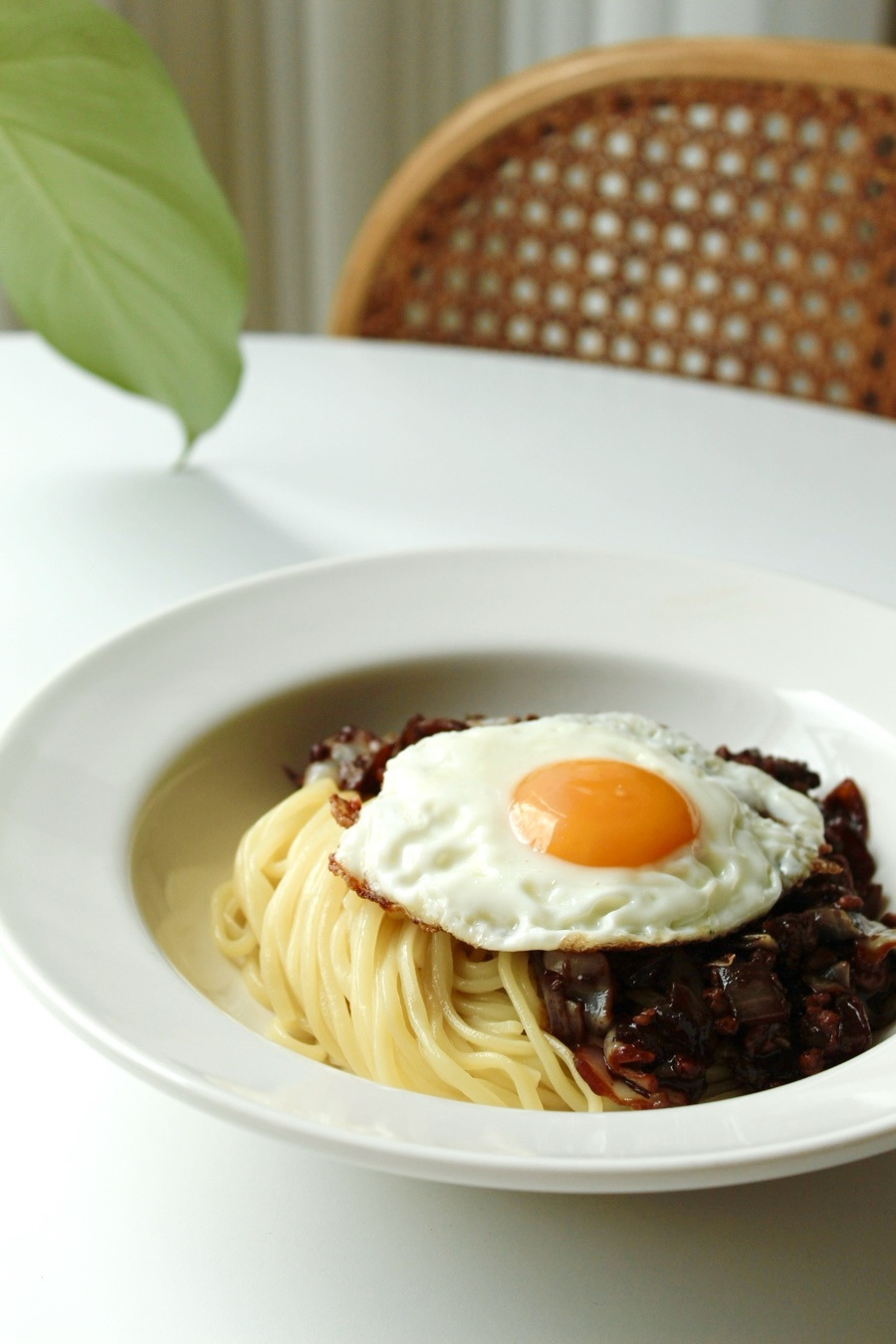Authentic Korean Jjajangmyeon (Gan Jjajang Style)
Homemade Black Bean Noodle Sauce Recipe / Classic Chinese-Korean Jjajangmyeon for Beginners

Discover how to make a delicious and authentic Korean Jjajangmyeon right in your own kitchen! This recipe focuses on creating a rich ‘Gan Jjajang’ style sauce, which means it’s made without added water or starch, resulting in a deeply savory and concentrated flavor from the stir-fried ingredients. We’ll start by ‘frying’ the black bean paste (chunjang) in oil, which significantly enhances its nutty aroma and depth. Fresh vegetables like onions and cabbage are generously used, along with pork, creating a hearty texture and balanced sweetness. For an even more authentic Chinese restaurant taste, consider adding MSG and lard (pork fat), and adjust the sugar to achieve your preferred sweet and savory profile. While I’m personally more of a Jjamppong fan, Jjajangmyeon holds special nostalgic value, reminding me of childhood celebrations. It remains a staple for moving days and a beloved comfort food in Korea. This recipe is perfect for anyone looking to recreate that classic Chinese-Korean dish with chewy noodles and a robust sauce. Let’s get cooking!
Gan Jjajang Sauce Ingredients (Serves 4)- 1.5 medium Onions, diced into ~1.5cm pieces
- 500g Chinese Cabbage (about 1/4 medium head), diced into ~1.5cm pieces
- 300g Pork (ground or diced)
- 1 Tbsp Minced Garlic
- 2 Tbsp Soy Sauce
- 2 Tbsp Oyster Sauce
- 2 Tbsp Dark Soy Sauce (optional, for deeper color)
- 3 Tbsp Sugar (adjust to taste)
- 3 Tbsp Roasted Chunjang (black bean paste)
For Serving- 2 servings Chinese Wheat Noodles (Jjajangmyeon noodles)
- 2 Fried Eggs
- Prepared Gan Jjajang Sauce
- 2 servings Chinese Wheat Noodles (Jjajangmyeon noodles)
- 2 Fried Eggs
- Prepared Gan Jjajang Sauce
Cooking Instructions
Step 1
Begin by preparing your vegetables. Dice 1.5 medium onions into roughly 1.5cm (about half an inch) cubes. If you prefer a finer texture known as ‘yuni jjajang’, chop them smaller. Remember that vegetables shrink considerably when cooked, so cutting them slightly larger than your desired final size is a good strategy.

Step 2
Next, dice 500g of Chinese cabbage (approximately 1/4 of a medium head) into similar 1.5cm cubes, matching the size of the onions. The amount of cabbage significantly impacts the sauce’s volume, so feel free to add more if you desire a larger batch.

Step 3
To prepare the diced vegetables, soak them briefly in water with a splash of vinegar, then rinse thoroughly under cold running water. Drain them well in a colander to remove excess moisture before they go into the pan. This helps remove any raw taste and ensures a fresher flavor.

Step 4
For the pork, you can use pork belly or any cut you prefer. I’m using 300g of ground pork. It’s crucial to pat the pork dry with paper towels to remove any excess blood, which can cause unwanted odors. If using diced pork belly, you can omit adding extra oil later as it will render its own fat.

Step 5
While you can use chunjang directly, roasting it in oil beforehand greatly deepens its flavor and aroma. Heat a generous amount of cooking oil in a wok or large pan over medium heat. Add the chunjang and stir continuously with a spatula, ensuring it doesn’t stick to the bottom.

Step 6
Continue stirring the chunjang until it becomes fragrant and starts to bubble slightly as it combines with the oil. Be careful not to burn it, as this will make it bitter. Once it reaches this stage, it’s ready. Overcooking can make it hard.

Step 7
Remove the roasted chunjang from the pan and set it aside. Leave about 2 tablespoons of the flavored oil in the pan; discard the excess. This infused oil will be the flavorful base for sautéing the other ingredients.

Step 8
Add the prepared pork to the pan with the remaining flavored oil. If using ground pork, break it up with your spatula as it cooks to prevent clumps. If you’re using fatty pork belly, you can cook it without adding any extra oil, letting its natural fat render out.

Step 9
Once the pork is fully cooked, add 1 tablespoon of minced garlic and stir-fry for about 30 seconds until fragrant. Then, add the diced onions and cabbage. Stir-fry everything together until the vegetables soften slightly and are well coated with the oil. This step releases the natural sweetness of the vegetables.

Step 10
Now, add the roasted chunjang back into the pan along with 2 tablespoons of soy sauce, 2 tablespoons of oyster sauce, 2 tablespoons of dark soy sauce (if using, for color), and 3 tablespoons of sugar. Stir everything thoroughly to combine. If the chunjang is clumpy, you can add a small amount of water to help dissolve it smoothly.

Step 11
This ‘Gan Jjajang’ recipe is designed to be thick and rich, with minimal added liquid. The moisture from the generous amount of onions and cabbage is enough. Taste the sauce and adjust seasoning if needed – add a bit more chunjang if it’s not salty enough. Aim for a well-balanced, savory flavor that complements the noodles. Your delicious Gan Jjajang sauce is now complete!

Step 12
Bring a large pot of water to a rolling boil. Add 2 servings of Chinese wheat noodles (jjajangmyeon noodles) and cook according to package directions. For fresh noodles, this usually takes about 3-4 minutes until they are al dente. Adjust cooking time based on the noodle type.

Step 13
Once the noodles are cooked, drain them immediately and rinse them under cold running water. This step washes away excess starch, preventing the noodles from becoming mushy and ensuring a better texture. Drain them thoroughly.

Step 14
Arrange the drained noodles neatly in serving bowls. Spoon a generous amount of the warm, freshly made Gan Jjajang sauce over the noodles. Top with a perfectly fried egg, with a slightly runny yolk if you like. Enjoy your homemade Jjajangmyeon!




